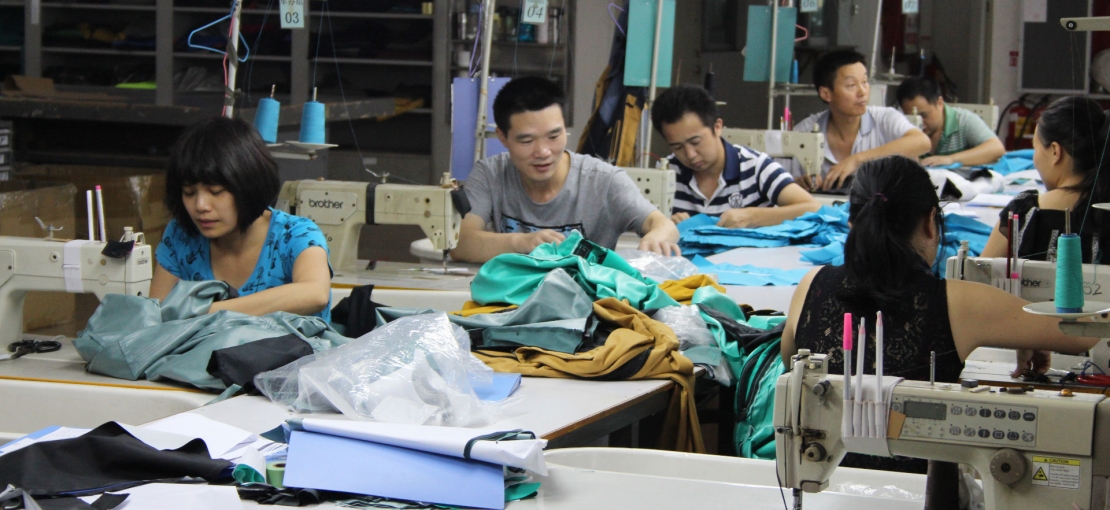
Our producers are our partners
We maintain long-term partnerships
VAUDE has a great interest in long-term relationships with producers. Frequently changing producers to obtain more favorable prices doesn’t correspond with our company philosophy. For VAUDE, it is important that the producers have an understanding of our VAUDE values and quality standards. We achieve this through many years of collaboration based on mutual trust. This foundation creates the conditions for open, constructive collaboration that helps us to shape and improve sustainable processes at the production sites.
Our goal: Year-round workloads
We think it is important to help strengthen our production sites. We have two objectives. We want to both achieve a year-round, uniform workload, and we want to increase the volume of orders from experienced producers. Everyone benefits from this: Our production partners increase efficiency and VAUDE can make greater change at the production sites which strengthens collaboration as a whole.
Good planning is essential
VAUDE develops and produces two collections annually: a Summer Collection and a Winter Collection. An exception is Packs ’n Bags, for which there are four collections annually. Because everyone in the outdoor industry uses these seasons, there are often when workloads are very intense during the high season. Therefore, it is very important that we support our production sites with good planning processes to help alleviate the burden.
To date, we have had a very good process that has given our producers planning security. In 2016 we again optimized our internal planning:
- Our planning team is involved at an early stage giving our producers volume forecasts and clarifying whether the producer has the necessary capabilities.
- This helps us balance out high season orders and produce during the low season as well.
- Orders for products that are sold through several seasons are placed earlier so that they can be manufactured during the low season.
- After the international sales meeting with our sales department, we verify our forecasts again and, if necessary, adjust them before we give the final orders to producers.
We require early, detailed and binding planning of quantities from our sales department. The more accurate our volume forecasts, the better the producer can plan and the less overtime is incurred during production.
Prices are negotiated and established very early with the producer. This usually happens during the product development phase based on cost breakdowns. In the cost break down, the producer records exactly what materials are used, what they cost, and other relevant costs incurred for product manufacturing.
After each season, we evaluate the producers' data with regard to adherence to deadlines, delivery, quality, quantity, working conditions, etc. and then discuss any improvement measures that may prove necessary.
Where are your VAUDE products manufactured?
Some of your VAUDE products will continue to be manufactured right here at our Manufaktur production facility at the company headquarters in Obereisenbach as well as elsewhere in Europe. However, the majority of all outdoor products – VAUDE's included – are made in Asia.
We have audited all of our producers in high risk countries
What are high risk countries?
In high risk countries, the likelihood that labor standards or laws are violated is greater than in non-risk countries. In these countries, institutions (such as trade unions, employee organizations, labor legislation, supervision systems) that guarantee compliance with labor standards either don't exist or don't function well. The Fair Wear Foundation categorizes all Asian countries as well as Bulgaria and Romania as high risk countries.
VAUDE has achieved the FWF's Leader Status. The FWF requires that its members have at least 90% of its factories audited. At VAUDE it is important it to have complete transparency. Therefore, all producers in high risk countries have been audited. VAUDE works with the producers on action plans for implementing corrections.
Special conditions for Myanmar
Eleven local producers close to our main headquarters
VAUDE worked with eleven producers in non-risk countries in the period under review. They accounted for 7.8 % of the total expenditure for our products. Five percent were products made here in southern Germany at our Manufaktur production facility.
Producers in non-risk countries are not audited because the risks are much lower. Nevertheless, our employees visit them regularly. In 2016, our CSR team visited all local producers with an emphasis on social standards. In an industry-wide comparison, these producers are relatively close to our main business site in Obereisenbach and are therefore referred to as local suppliers.
| GRI: | G4-HR10 |
| GRI: | G4-HR11 |
| GRI: | G4-EC9 |
| GRI: | G4-LA14 |
| GRI: | G4-LA15 |
| GRI: | G4-DMA Aspect of procurement |






